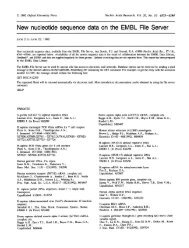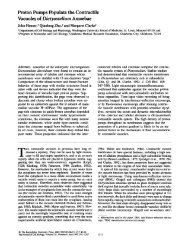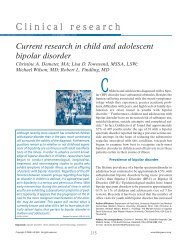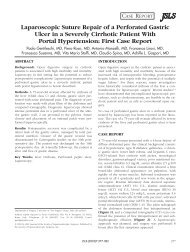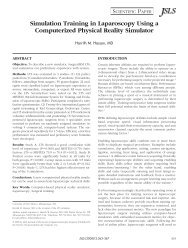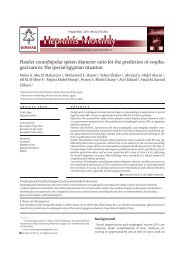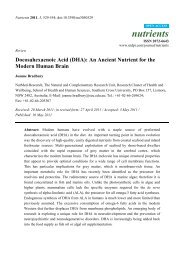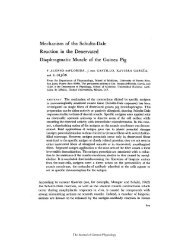Download PDF - BioMedSearch
Download PDF - BioMedSearch
Download PDF - BioMedSearch
You also want an ePaper? Increase the reach of your titles
YUMPU automatically turns print PDFs into web optimized ePapers that Google loves.
Author Summary<br />
Mitochondrial carrier proteins evolved during endosymbiosis<br />
to transport substrates across the mitochondrial inner<br />
membrane. As such the proteins are associated exclusively<br />
with eukaryotic organisms. Despite this, we identified<br />
putative mitochondrial carrier proteins in the genomes of<br />
different intracellular bacterial pathogens, including Legionella<br />
pneumophila, the causative agent of Legionnaire’s<br />
disease. We named the mitochondrial carrier protein from<br />
L. pneumophila LncP and determined that the protein is<br />
translocated into host cells during infection by the<br />
bacterial Dot/Icm type IV secretion system. From there,<br />
LncP accesses the classical mitochondrial import pathway<br />
and is incorporated into the mitochondrial inner membrane<br />
as an integral membrane protein. Remarkably, LncP<br />
crosses five biological membranes to reach its final<br />
location. Biochemically, LncP is a unidirectional nucleotide<br />
transporter similar to Aac1 in yeast. Although not essential<br />
for intracellular replication, the high carriage rate of lncP<br />
among isolates of L. pneumophila suggests that the ability<br />
of the pathogen to manipulate mitochondrial ATP<br />
transport assists survival of the bacteria in an intracellular<br />
environment.<br />
Carrier Family (MCF), termed LncP for Legionella nucleotide<br />
carrier Protein. MCF proteins are a signature family of eukaryotic<br />
proteins that evolved in the course of endosymbiosis, ultimately<br />
giving rise to mitochondria [28]. MCF proteins are found in the<br />
broadest distribution of eukaryotes, including humans, yeast,<br />
plants and parasites such as trypanosomes and amoebae [29–32].<br />
In humans, yeast and other eukaryotes, MCF proteins are<br />
synthesized in the cytoplasm and enter mitochondria via a defined<br />
‘‘carrier pathway’’. The proteins are chaperoned through the<br />
cytosol by Hsp70/Hsp90 and delivered to the Tom70 receptor on<br />
the mitochondrial surface [33]. After threading through the<br />
channel in the outer mitochondrial membrane, unfolded MCFs<br />
are bound by the TIM9:10 chaperone in the intermembrane space<br />
and then assembled into the mitochondrial inner membrane by<br />
the TIM22 complex (reviewed in [34–37]). Here we found that<br />
LncP was translocated into host cells by the Dot/Icm type IV<br />
secretion system and transported into the mitochondrial inner<br />
membrane by the mitochondrial TIM9:10 chaperones and the<br />
TIM22 complex. A yeast model system and biochemical transport<br />
assays suggested that LncP mediated the unidirectional transport<br />
of ATP. In this otherwise exclusively eukaryotic group of proteins,<br />
LncP is the first example of a MCF member from bacteria that<br />
may contribute to the persistence of L. pneumophila within<br />
eukaryotic cells.<br />
Results<br />
Legionella pneumophila Encodes a Putative Mitochondrial<br />
Carrier Protein<br />
When the UniProt data set of protein sequences was screened<br />
with a hidden Markov model for mitochondrial carrier family<br />
(MCF) proteins, an expected number of MCF proteins were<br />
detected in mammals, plants and fungi [38–42] and a smaller<br />
number in protists such as Entamoeba histolytica [32]. Unexpectedly,<br />
a handful of protein sequences was also retrieved from bacteria.<br />
Two of these were encoded in the genome of the intracellular<br />
pathogen Neorickettsia sennetsu, the causative agent of Sennetsu fever<br />
[43,44]. Three other carriers were encoded in the genome of L.<br />
longbeachae (Llo1924, Llo3082 and Llo1358), with Llo1924 having a<br />
A Mitochondrial Carrier Protein in Legionella<br />
homolog (sequence identity of 57%; Figure 1A), encoded in the<br />
genome of the related pathogen L. pneumophila strain 130b (openreading<br />
frame LPW_31961) [45,46]. The putative MCF protein<br />
from L. pneumophila was subsequently termed LncP.<br />
The crystal structure of the prototypical MCF, the adenine<br />
nucleotide transporter from mammals, shows that the protein has<br />
six transmembrane segments that are embedded in the mitochondrial<br />
inner membrane [47]. Bioinformatic analysis indicated that<br />
the amino acid sequences of Llo1924 and LncP had six predicted<br />
transmembrane segments and a three-fold repeated signature motif<br />
(Figure 1A) which are the essential characteristics of members of the<br />
MCF (Figure 1B) [38–42]. MCF proteins differ to nucleotide<br />
carriers in the inner membranes of the Chlamydiales and the<br />
Rickettsiales, which represent different family of proteins, referred<br />
to as TLC ATP/ADP transporters (PF03219) [48,49]. This latter<br />
group is of bacterial origin, and has spread from chlamydial<br />
ancestors to other classes of bacteria and to chloroplasts via lateral<br />
gene transfer events. TLC ATP/ADP transporters contain twelve<br />
transmembrane segments and their nucleotide exchange properties<br />
do not require membrane potential [50].<br />
LncP Is Targeted to Mitochondria during Infection in a<br />
Dot/Icm T4SS-dependent Manner<br />
Many eukaryotic-type proteins from L. pneumophila are translocated<br />
into infected cells via the Dot/Icm type IV secretion system.<br />
To determine if LncP was a Dot/Icm effector, we generated a<br />
translational fusion of the calmodulin-dependent adenylate cyclase<br />
from Bordetella pertussis (CyaA), with the N-terminus of LncP (Cya-<br />
LncP). The Cya-LncP fusion construct was introduced into wild<br />
type L. pneumophila 130b or a dot/icm (dotA) mutant [51]. Upon<br />
infection of THP-1 macrophages, Cya-LncP translocation was<br />
detected by increased cyclic AMP (cAMP) production at levels<br />
similar to the positive control (Cya-RalF) (Figure 2A). This<br />
translocation was dependent on dotA indicating that LncP is a<br />
Dot/Icm effector. Compared to eukaryotic MCF members, LncP<br />
carries a short amino acid extension at the C-terminus (Figure 1A).<br />
As the secretion signal for many Dot/Icm effectors lies in the Cterminus<br />
of the protein [52,53], we tested whether this region<br />
contained a Dot/Icm secretion signal, however deletion of the Cterminal<br />
amino acid residues PTRKR had no effect on Dot/Icm<br />
dependent translocation (Figure 2A).<br />
To determine if LncP localized to mitochondria during infection<br />
of macrophages, we generated a 4HA epitope-tagged version of<br />
LncP for expression in L. pneumophila. The resulting expression<br />
plasmid, p4HA-LncP, was transformed into wild type L.<br />
pneumophila 130b and the dotA mutant. Upon infection of<br />
macrophages for 5 h with 130b carrying p4HA-LncP, anti-HA<br />
staining co-localized extensively with Mitotracker red in infected<br />
cells (Figure 2B). Anti-HA staining was not observed in<br />
macrophages infected with L. pneumophila 130b carrying the empty<br />
vector, pICC562, or in macrophages infected with the dotA mutant<br />
carrying p4HA-LncP (Figure 2B). Similar results were observed<br />
upon L. pneumophila infection of HeLa cells (Figure S1). We<br />
detected increasing amounts of LncP associated with mitochondria<br />
over time (Figure 2C) and at earlier time points, we frequently<br />
observed LncP staining at the poles of the bacterial cell where the<br />
Dot/Icm secretion system is believed to be located (Figure 2C).<br />
Altogether, this demonstrated that LncP was localized to<br />
mitochondria during L. pneumophila infection and this event relied<br />
upon a functional dot/icm system.<br />
Many genes encoding Dot/Icm effectors are dispensable for<br />
intracellular replication due to functional redundancy [9],<br />
reviewed in [6]. Likewise here, the gene encoding LncP was<br />
not required for L. pneumophila 130b intracellular replication in<br />
PLoS Pathogens | www.plospathogens.org 2 January 2012 | Volume 8 | Issue 1 | e1002459



